The Pickleball Phenomenon
Pickleball, a sport combining elements of tennis, badminton, and ping pong, has experienced a surge in popularity in recent years. Originating in the United States in the 1960s, it started as a backyard game and has since become a recognized sport with organized leagues, tournaments, and dedicated pickleball communities worldwide. According to the Sports & Fitness Industry Association (SFIA), pickleball participation has grown by 158.6% in the last three years and continues to be the fastest-growing sport in the United States.1 With this gain in popularity, in September 2020, Apple added pickleball as an option in the Workout app.
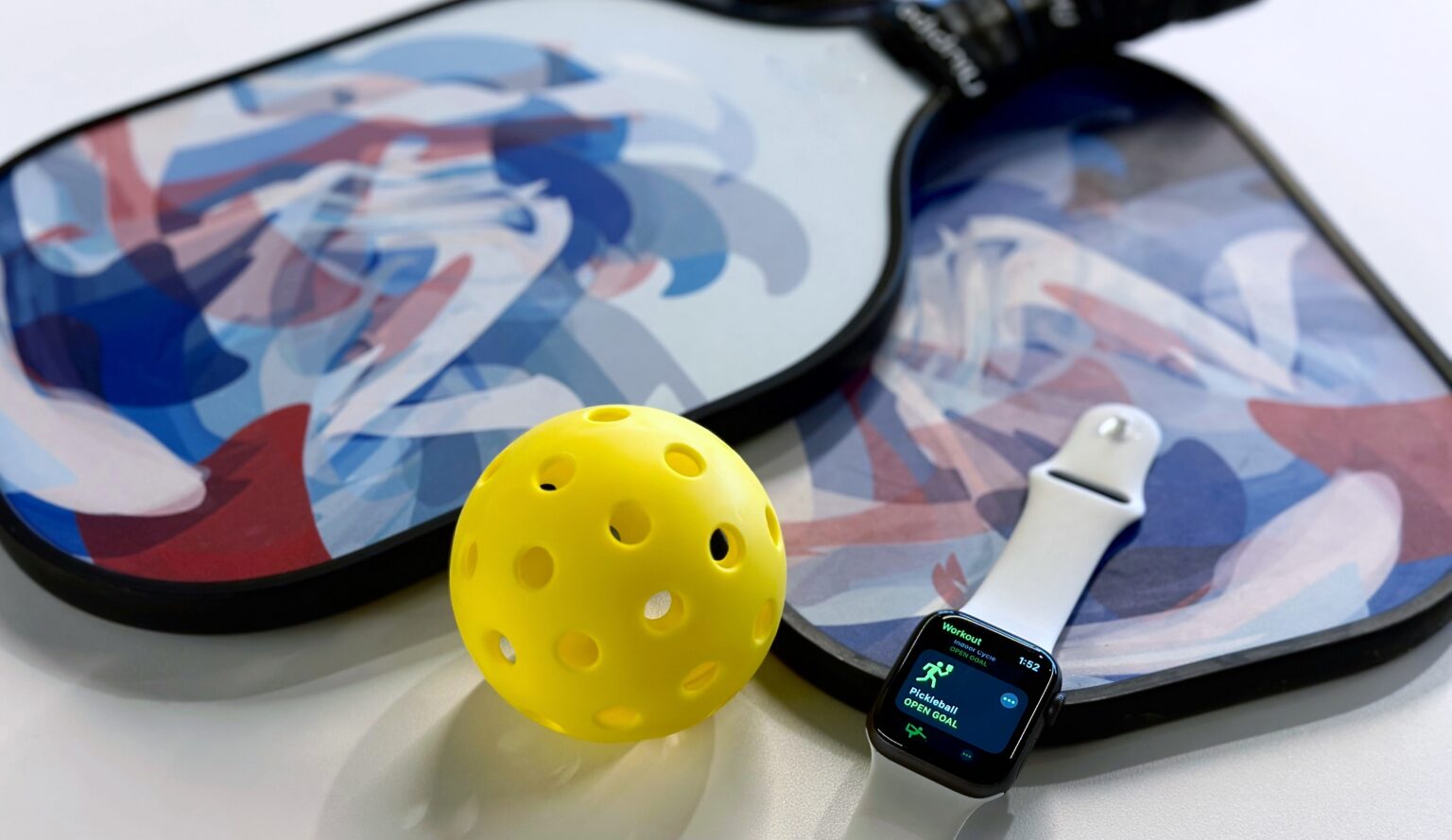
In this Study update from the Apple Heart and Movement Study (AHMS), we explore the emerging sport of pickleball and compare it to the long-standing sport of tennis using data from participants who provided informed consent to participate in AHMS. For this work, workouts labeled by participants as pickleball or tennis of at least 10 minutes duration and recorded between January 1st, 2021, and August 31st, 2023, were included in the following analyses.
Which is more popular among Study participants, pickleball or tennis?
Looking first at how many unique participants recorded at least one pickleball or tennis workout each month, Figure 1 reflects the rise in pickleball in the AHMS cohort. While participants recording tennis workouts remained relatively stable year over year, albeit with considerable seasonal variation, the number playing pickleball continued to increase, regardless of season. For the first time, in July of 2023, the number of participants playing pickleball in a single month surpassed tennis. In August, 1,331 participants recorded at least one pickleball workout, while only 1,243 recorded a tennis workout, and 106 participants recorded both. Across the 32 months analyzed, the sum of participants that have recorded either sport at any point includes 4,799 pickleball and 7,780 tennis players.
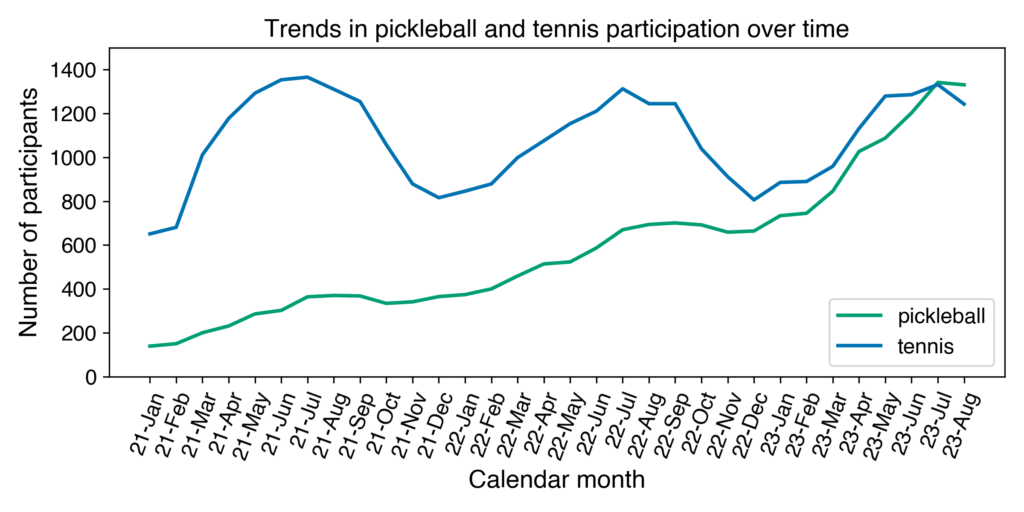
Who is playing pickleball and tennis?
Among AHMS participants, pickleball and tennis were popular across all ages, and both were more popular in men than women. Participants in this Study ranged in age from 18 to 93 years. As shown in Table 1, pickleball and tennis were recorded in participants as young as 18, while the oldest participant reporting pickleball was 84 and tennis was 92 years of age! On average, pickleball players were older than tennis players with higher female participation rates. Both saw an average increase in age with more frequent play (at least 10 workouts).

The age distribution of the overall AHMS study participants and those who recorded at least one pickleball or tennis workout appears in Figure 2. Tennis has a similar distribution to the participant population, whereas pickleball has a higher overall age and more varied distribution.
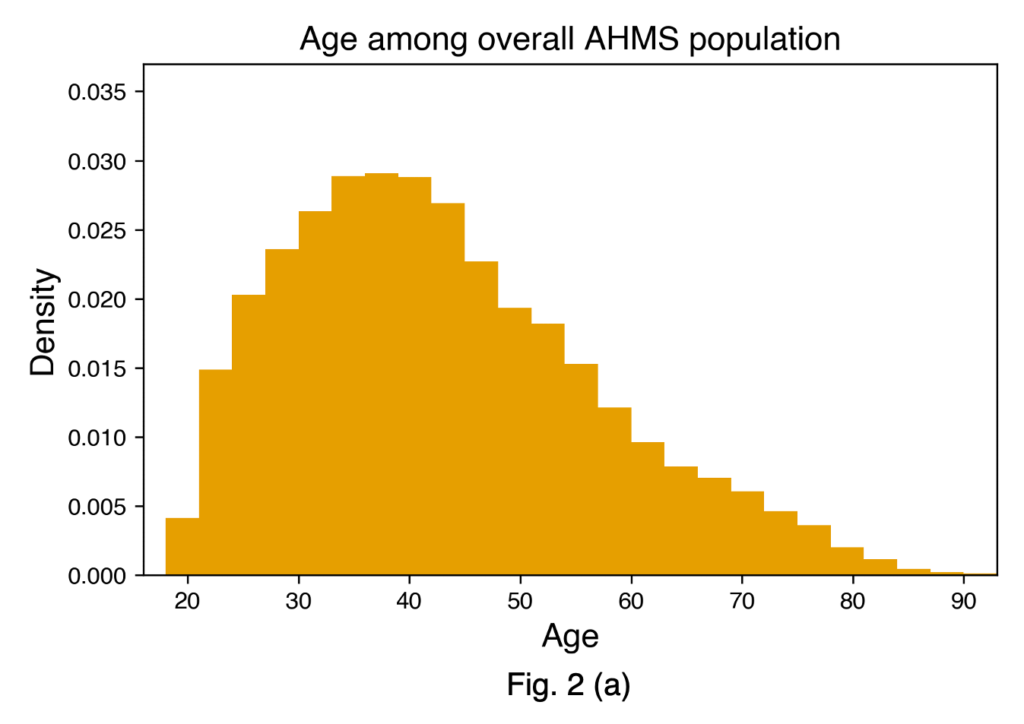
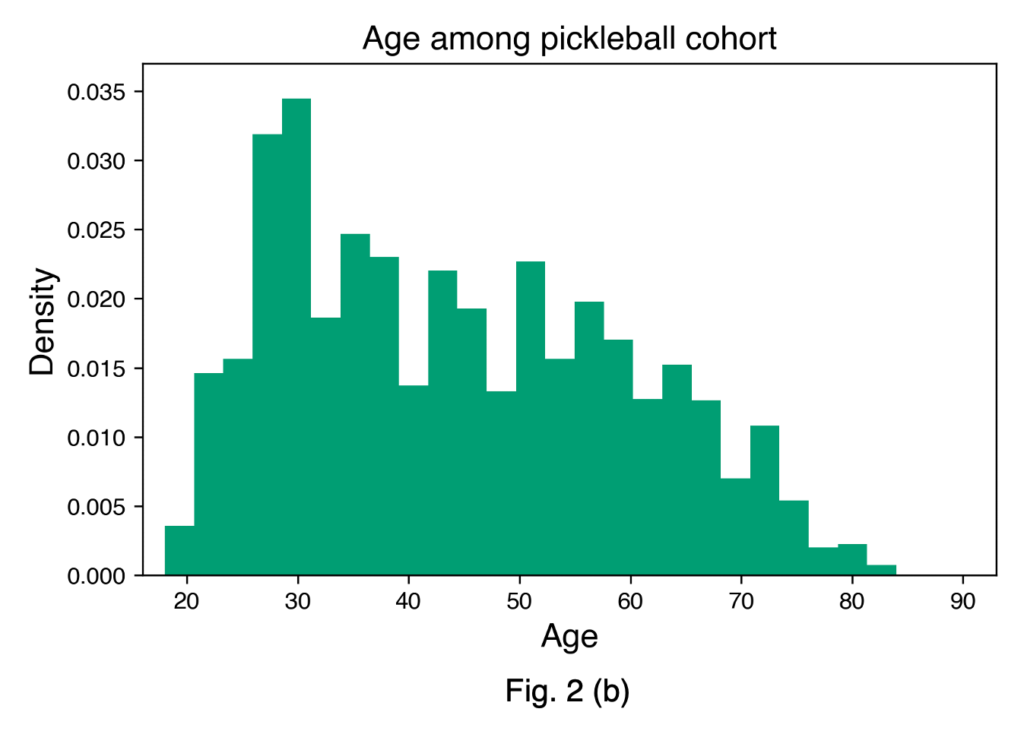

Figure 2: These density plots show the age distribution of the overall AHMS population 2(a) (N = 210,165, average age = 42 +/- 14) in comparison to those who recorded 1 or more pickleball 2(b) (N=4,799, average age = 44 +/- 15) or tennis workouts 2(c) (N=7,780, average age = 40 +/- 13). Participant age as of August 31st, 2023, was used.
Interestingly, Utah stood out as the most popular state per capita for pickleball (number of participant players/number of total participants enrolled in that state), with just over 1 in every 16 Study participants in the state giving the sport a try at least once. Utah is among the top states, along with Arizona and California, for the highest number of dedicated pickleball courts per 1,000 residents (4.6).1
Is the duration and intensity of pickleball different than tennis among participants?
To look at how much time participants spend in an individual pickleball or tennis workout, the distribution of workouts with a duration of 10 minutes to 4 hours are plotted in Figure 3, which captures well over 95% of workouts recorded for each sport. This allowed us to analyze more than 250,000 individual workouts including 94,596 pickleball workouts in 4,794 participants, and 162,089 tennis workouts in 7,770 participants.
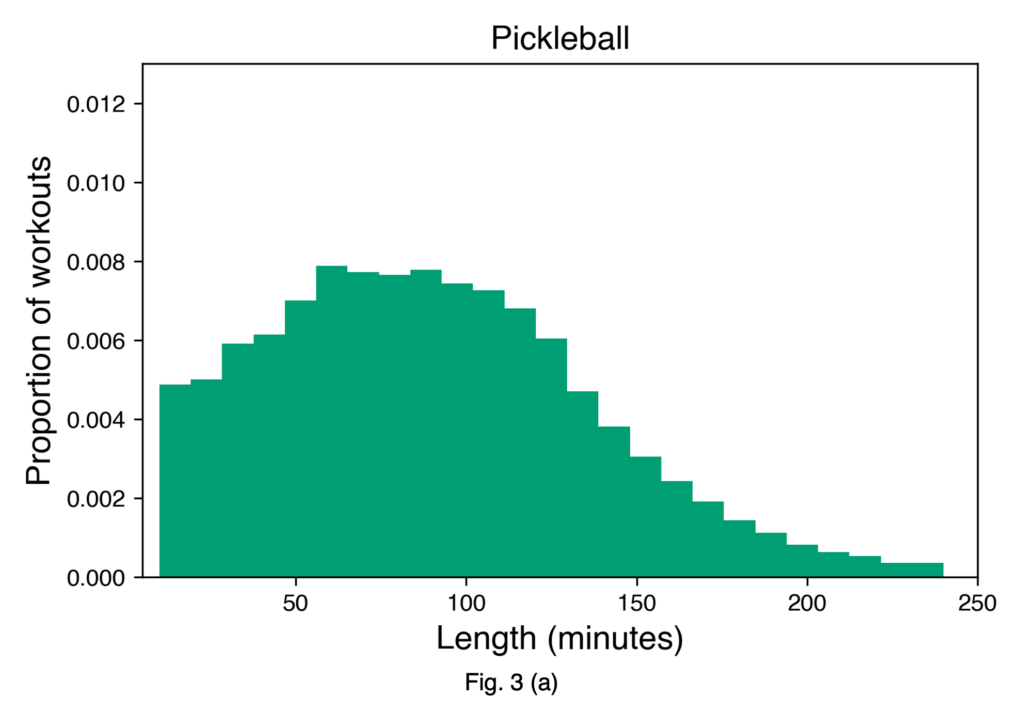
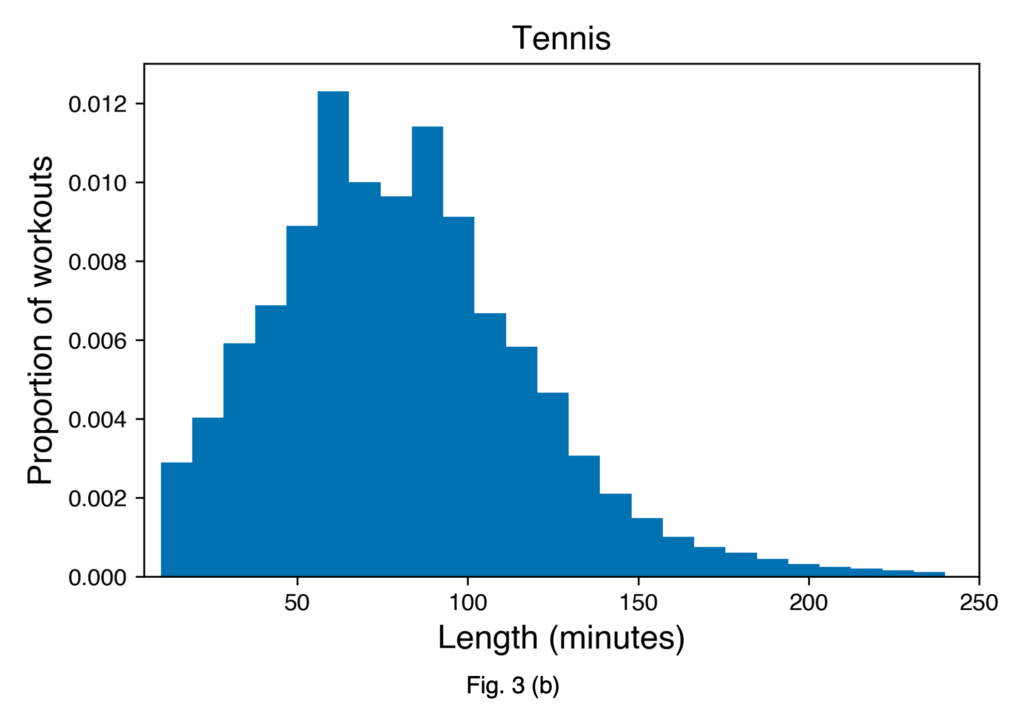
Figure 3: These density plots show the distribution of workouts between 10 and 240 minutes for all workouts recorded as pickleball (3a) and tennis (3b).
On average, pickleball workouts were longer with greater variability in the time played, averaging 90 +/- 47 minutes, than tennis, averaging 81 +/- 38 minutes.
To compare intensity, we evaluated heart rate data recorded during pickleball and tennis workouts recorded in 2022 (97,881 workouts in 5606 participants). Workouts were included in the analyses below if heart rate was measured at 5-second intervals for at least 75% of the workout with 70,603 workouts remaining (26,683 pickleball and 43,920 tennis workouts belonging to 4,967 participants).
Peak heart rate, the highest heart rate an individual reaches at any point during an exercise, can be used to assess effort, when compared to an estimate of the upper limit of beats per minute possible, maximum heart rate (Max HR). Each workout was labeled with the participant’s age and the peak heart rate achieved within that workout. The Max HR was calculated using the age-based Tanaka formula, Max HR = 208 – 0.7 x age.2 Figure 4 plots both the pickleball and tennis average peak heart rate achieved for each age group in the Study (filtered to display ages 19 to 74 years of age for a sufficient sample size). The shaded area represents 70 to 100% of the estimated maximum heart rate. Typically, peak heart rate declines with age because the achievable maximum heart rate decreases over time. For each age represented in the Study, both sports averaged a peak heart rate within 70% the estimated Max HR. The average peak heart rate was 9 beats per minute faster during tennis workouts which averaged 152 bpm compared to 143 bpm in pickleball.
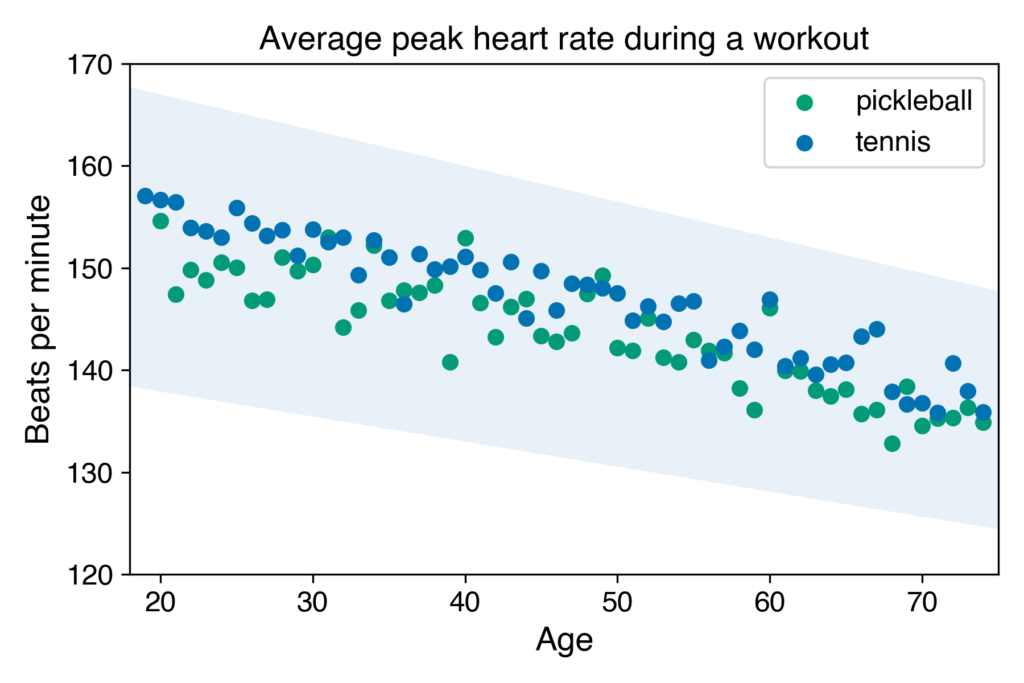
Time spent in target heart rate zones is another way to assess exercise intensity and to gauge whether someone achieves recommended activity guidelines. There are various ways scientists have defined these zones and what qualifies as moderate or vigorous exercise.3,4 To assess intensity levels, we used the same data from the above peak heart rate analysis and calculated individualized heart rate zones for each participant based on heart rate reserve (HRR). This formula requires age, resting heart rate (RHR), and target percentages to determine zones for each individual. Details of the calculations are shown below:
- Max HR: as previously defined, 208-0.7 × age, Tanaka formula
- RHR: daily resting heart rate values collected on Apple Watch throughout 2022 for each AHMS participant, median value selected
- HRR = Max HR – RHR
- Zone calculation = HRR x % range for the zone + RHR
We defined light exercise as <60% of HRR, or Zone 1 on Apple Watch, moderate as 60 to <80%, Zone 2 and 3, and vigorous as >=80%, Zone 4 or 5. Figure 5 below demonstrates that, while each sport has similar trends in the time spent in each zone, tennis workouts average 9% more time spent in moderate and vigorous heart rate zones combined (Zones 2 – 5) than pickleball workouts.
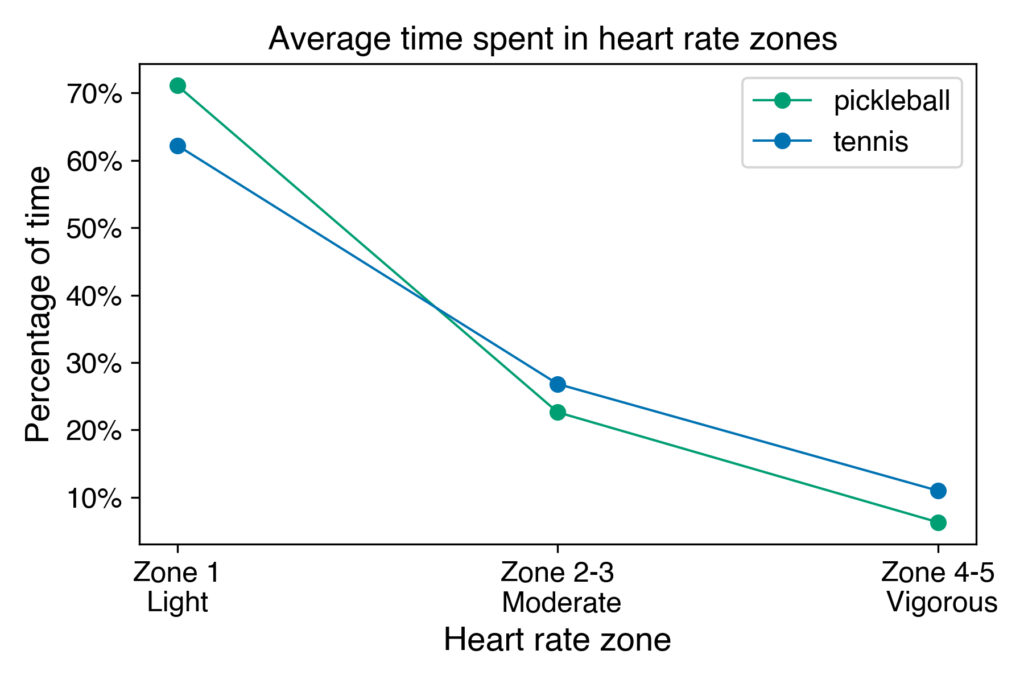
While the Study team cannot determine the differences that may exist in a doubles or singles match across either sport, the data show that both pickleball and tennis are often played for long periods of time with heart rates rising over 70% of estimated Max HR levels on average. These types of activities are strongly associated with quality of life and healthy aging.
Is there a correlation between racquet sports and mental health?
Outside of the physical benefits of exercise, it is also important to consider the impact activity can have on mental health. All participants in the Apple Heart and Movement Study are invited to complete an optional quarterly Mental Health survey. The survey includes a depression screening tool called the Patient Health Questionnaire-2 (PHQ-2). The PHQ-2 is often the first step to identifying possible depression by inquiring about the frequency of depressed mood and anhedonia (loss of ability to feel pleasure) over the past two weeks. PHQ-2 scores can range from 0-6, with a score of 3 or higher being associated with a depressed mood and driving the recommendation for further evaluation.5
To analyze potential differences in scores between the general AHMS population and those who frequently play tennis or pickleball (at least 10 or more) in 2022, we calculated the average PHQ-2 score for each individual Study participant. To be included in this analysis, participants had to be enrolled prior to April 1st, 2022, and must have completed at least one PHQ-2 survey in quarter 4, resulting in 24,450 participants. The purpose of this criteria is to help ensure the PHQ-2 scores are representative of the full year. Figure 6 shows the distribution of these averaged scores with the red line indicating the threshold associated with depressed mood. Screening results associated with depressed mood (score of 3 or higher) were rare. In the overall population, the median score was 0.5, however, the median scores among frequent pickleball and tennis players are both lower with median scores of 0.
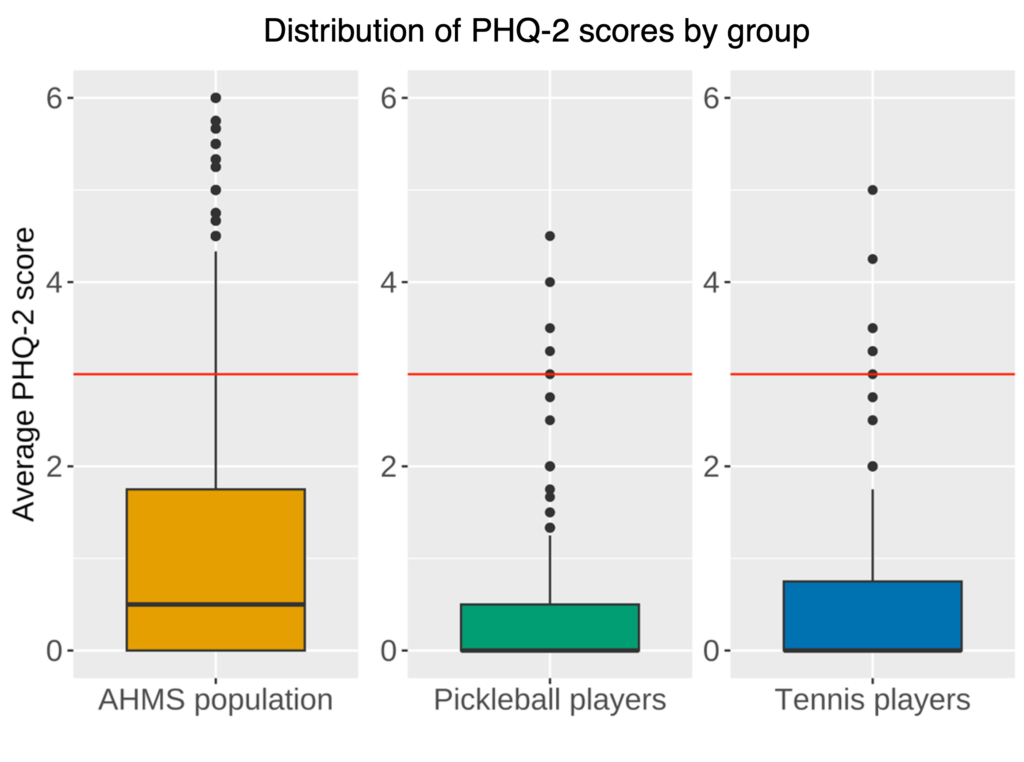
To account for known differences between these groups, an additional analysis was done by fitting a regression model to predict the likelihood of a screening result associated with depressed mood for frequent tennis and pickleball players. The model adjusted for age, assigned sex, ethnicity, self-reported relative socioeconomic status, and self-reported activity level. , we developed an averaged numeric grading score from the question “How frequently were you physically active over the last four weeks?” with answer options of: “No physical activity,” “Less than once a week,” “One to three times a week,” “Four or more times a week,” and “I prefer not to answer.” In our initial model, the odds of a screening result above the threshold associated with depressed mood were 60.1% (p-value < 0.05) lower among frequent pickleball players. We found a similar association among frequent tennis players (51.3%, p-value < 0.05) and for self-reported overall activity levels (46.5%, p-value < 0.05) for each increase in activity level reported. These results highlight the known relationships between activity and mood.
While this is an interesting finding, there are several important limitations to consider. The PHQ-2 screening tool is not considered to be a comprehensive assessment tool and completion of surveys is optional for all participants.
Are there risks to playing pickleball or tennis?
While pickleball and tennis offer potential benefits, it is important to approach either game with some caution. As with any physical activity, there is a risk of injury, especially if proper techniques and precautions are not followed. In the Apple Heart and Movement Study, to date, there were 38 confirmed falls via phone call follow-up related to pickleball or tennis with injuries that ranged from scrapes and bruises to fractures of the hip and wrist. These data represent what has been reported in Study participants and so this is not a comprehensive list of risks.
If you’re considering introducing pickleball or tennis into your fitness regimen, consult with your medical team before engaging in physical activity, follow their guidance and consult a qualified healthcare provide for any injury or health-related concerns.
Conclusion:
Pickleball’s popularity continues to grow as more people recognize its approachability, health benefits, and social advantages. Both pickleball and tennis are fast-paced sports that appeal to individuals of all ages and fitness levels, providing a fun and engaging way to stay physically activity. Any exercise or physical activity, such as pickleball and tennis, can help improve physical fitness, mental well-being, and cardiovascular and metabolic health.
A final note to AHMS Participants:
While this update focuses on pickleball and tennis, the Study team is looking at Apple Watch data across all workout types to determine the impact of physical activity on health. Wearing an Apple Watch and recording your workouts using the Workout app increases the Study team’s ability to gain more robust insights. If you are a participant in the Study and are unsure of how to log workouts, please visit https://support.apple.com/en-us/HT204523.
Thank you to all our Apple Heart and Movement Study participants.
Get the app. Join the Study.
- Sports & Fitness Industry Association (SFIA) (n.d.). Pickleball sees unprecedented growth: Will require 25,000 courts built, $900 million investment to keep up with demand. Retrieved September 16, 2023, from https://sfia.org/resources/pickleball-sees-unprecedented-growth-will-require-25000-courts-built-900-million-investment-to-keep-up-with-demand/
- Tanaka H, Monahan KD, Seals DR. Age-predicted maximal heart rate revisited. J Am Coll Cardiol. 2001 Jan;37(1):153-6. doi: 10.1016/s0735-1097(00)01054-8. PMID: 11153730.
- American Heart Association (2021, March 9). Target Heart Rates Chart. Retrieved September 16, 2023, from https://www.heart.org/en/healthy-living/fitness/fitness-basics/target-heart-rates.
- Centers for Disease Control and Prevention (2022, June 3). Target Heart Rate and Estimated Maximum Heart Rate. Physical Activity. Retrieved September 16, 2023, from https://www.cdc.gov/physicalactivity/basics/measuring/heartrate.htm
-
Kroenke K, Spitzer RL, Williams JB. The Patient Health Questionnaire-2: Validity of a Two-Item Depression Screener. Medical Care. 2003;41:1284-92.
